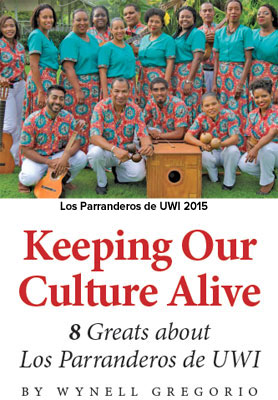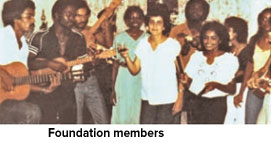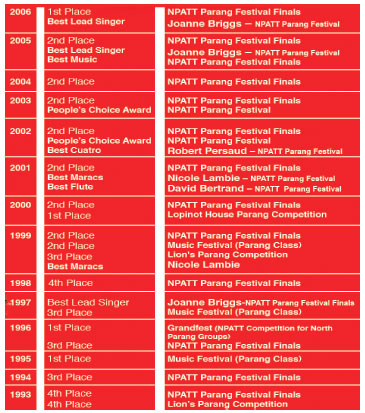|
December 2017

Issue Home >>
|

 Many of us have triggers for the holiday season – the first sound of soca-parang “Leroy, where yuh mudder gone?” on 100.1 FM’s “100 days of Christmas;” the smell of a freshly opened tin of white Sissons oil paint for the banisters and other parts; the sight of an inflated Santa; icicle lights, Christmas trees and poinsettia. For me, it’s the sound of a cuatro strumming, maracas shaking and the melodious voice of Joanne Briggs and team singing “Rio Manzanare” in front of the Daaga Auditorium at The UWI. Many of us have triggers for the holiday season – the first sound of soca-parang “Leroy, where yuh mudder gone?” on 100.1 FM’s “100 days of Christmas;” the smell of a freshly opened tin of white Sissons oil paint for the banisters and other parts; the sight of an inflated Santa; icicle lights, Christmas trees and poinsettia. For me, it’s the sound of a cuatro strumming, maracas shaking and the melodious voice of Joanne Briggs and team singing “Rio Manzanare” in front of the Daaga Auditorium at The UWI.
That’s when my Christmas season kicks in.
From September to December, once you’re on the St. Augustine Campus on a Thursday evening, whether playing football on top field, exercising or wrapping up a day’s work, it’s hard not to be drawn into the infectious sounds of the parang band. This fascination, coupled with my love for parang compelled me to approach the band’s PRO, Miguel Browne to learn more about the group, Los parranderos de UWI.
I’m sharing a Listicle of eight interesting facts about the band and their contribution to local culture from the book, “Nuestra Cancion,” and interviews with the PRO, Miguel Browne.
#1 The Name
In the early years, the group was called "Los Parranderos Universitarios" (translated as the University parranderos). This proved to be a tongue twister for many and so the group came to be affectionately called "Los de UWI" but this omitted the key description and definition of their name. After a period of normalization, the title “Los Parranderos de UWI" was established and remains a strong element of their brand.
#2 The beginning
 The origins of the group are deeply rooted in The UWI St. Augustine Campus and can be traced right back to 1979. That year a group of students from the Spanish Society decided to form a parang group primarily to sing at their annual "Tertulia" event. The group proved immensely popular and was invited to perform at other campus functions during that season. Students of that era will long remember the enthusiastic response at the Social Sciences fete to the extent that many students shunned the DJ music and followed the group all the way to Trinity Hall just to hear the group perform again. Given the enthusiastic response, the 1980 season witnessed the formation of a parang group open to students of the campus fraternity. The origins of the group are deeply rooted in The UWI St. Augustine Campus and can be traced right back to 1979. That year a group of students from the Spanish Society decided to form a parang group primarily to sing at their annual "Tertulia" event. The group proved immensely popular and was invited to perform at other campus functions during that season. Students of that era will long remember the enthusiastic response at the Social Sciences fete to the extent that many students shunned the DJ music and followed the group all the way to Trinity Hall just to hear the group perform again. Given the enthusiastic response, the 1980 season witnessed the formation of a parang group open to students of the campus fraternity.
#3 The music
The repertoire has changed significantly over the years. As the group matured, there was a steady shift towards a repertoire that also consisted of the compositions of group members themselves. Early leaders such as Donna Marie Bertrand (1982-1983) and Keith Dalip (1987-1990) began this trend by penning compositions.
- Donna-Marie Bertrand, for example, gave the group “Salve María,” Keith Dalip penned “Canta.”
- Theresa Cardinez wrote “Mil Felicidad” and “Dios de Santa María.”
- “Nacido” written by Francisca Allard whose brother Phillip was a member of the group also became a group favourite in those early days.
- Camille Renwick (1993 to 2002 penned a string of aguinaldos and nacimientos for the group to perform at the NPATT Finals. These included “La Maravilla” (1997), “Si Es Verdad” (1998) and “Gloria A Ti” (2000).
- Collaborative efforts between group members such as “Recordemos” (Alan Donawa, Roger Achong and Sheldon Redhead - 1988), “Santa María” (Robert Persaud and Kathy-Ann Joseph - 1996) and “La Virgen Santa” (Desdra Bascombe and Sonja Gibbs - 2004).
- Dr. Sylvia Moodie, then Director of the Centre For Language Learning(CLL), has given generously of her time and expertise in overseeing the group’s compositions. In fact, the group’s winning composition “El Buen Posadero” in 2006 was co-written by her. Despite the increasing number of original compositions in the repertoire over the years, the group has remained committed to singing standard favourites by stalwarts such as Henry Pereira and others as a means of acknowledging their significant contribution to the artform.
#4 Recordings
2003 marked a major turning point in the evolution of the band when it began recording. Mi Parranda (2003) was the group’s first recording followed by two other CDs to mark its 25th and 30th anniversaries. The recording process not only allowed the band to highlight its original compositions but also to pay tribute to some of the stalwarts and elders in the parang world. The fact that alll three recordings continue to be seasonal best sellers is testimony to the success of the transition to a recording group.
#5 Competitions

# 6 Overseas Tours
Given its successes in the national parang competitions in 1993 and 1994, Los Parranderos de UWI was selected by NPATT (National Parang Association of Trinidad and Tobago) to perform in Venezuela during the first week of December 1995. The group was well received by Venezuelan audiences wherever it performed.
As National Parang Champions of 2006, Los Parranderos de UWI was invited by Kas di Cultura (Ministry of Culture Netherland Antilles) to participate in the Christmas Folk Festival held in Curaçao in 2007. The annual Festival features folk groups from the Caribbean region presenting traditional Christmas songs, dances and customs of their respective countries. Los Parranderos de UWI was the first group from the English-speaking Caribbean to be represented at the seven-year-old festival. Given the enthusiastic response to the group in 2007, it was invited once again to participate in 2008.
#7 Milestones
Apart from the accolades listed earlier in # 5, one of the major milestones was the celebration of the group’s 35th anniversary in 2015 which was a grand achievement in the dedication to local culture. This most recent momentous occasion was commemorated with a grand concert and the group’s history was thoroughly captured in the book/CD, “Nuestra Cancion.”
# 8 The talent
While the band’s work has amassed several accolades over its 35-year history, more can be said about its members who are rather talented people. There has been a series of individual awards for singing, percussion and strings among others. This close-knit team understands the value of not just talent, but dedication and passion for the art form. A thorough description of the band members and their personal stories are in the pages of “Nuestra Cancion” as they pay tribute from foundation members to the current group of twenty or so band members. Even better, take a quick scroll through their vivid photos and sprightly videos on face book to get a true taste of what they have to offer and I promise you won’t be disappointed. If you’re UWI staff, student, alumni or more so a Trinbagonian, you’d be proud of this band and their impact on local music and culture.
To learn more about the band, check Los Parranderos de UWI on face book or contact PRO, Miguel Browne 761-7514
|





